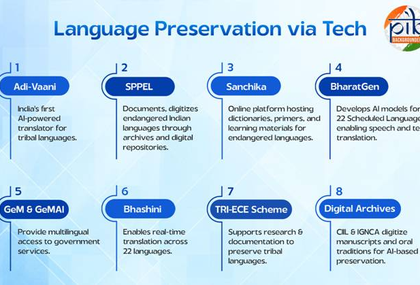Bhashini, BharatGen, Adi-Vaani positioning India as global leader in multilingual innovation
By IANS | Updated: October 25, 2025 18:05 IST2025-10-25T18:02:19+5:302025-10-25T18:05:16+5:30
New Delhi, Oct 25 India is emerging as a global leader in multilingual innovation with platforms such as ...

Bhashini, BharatGen, Adi-Vaani positioning India as global leader in multilingual innovation
New Delhi, Oct 25 India is emerging as a global leader in multilingual innovation with platforms such as Bhashini, BharatGen, and Adi-Vaani, the government said on Saturday.
India’s linguistic landscape is among the most diverse in the world, with 22 Scheduled Languages and hundreds of tribal and regional dialects spoken across its vast geography.
To preserve its rich linguistic heritage, the government is leveraging advanced technologies such as Artificial Intelligence (AI), Natural Language Processing (NLP), machine learning, and speech recognition to build intelligent, scalable language solutions.
The key platforms driving linguistic inclusion include Bhashini and BharatGen, which offer multilingual support, while Adi-Vaani aims to bring tribal languages into the digital fold.
“India’s future in language preservation is powered by cutting-edge technology, integrating AI and digital archives to keep its rich linguistic heritage vibrant and accessible. Platforms like Bhashini, BharatGen, and Adi-Vaani, along with targeted initiatives such as SPPEL and TRI-ECE, empower citizens nationwide to engage with services in their native languages,” the government said in an official statement.
“This comprehensive approach not only safeguards India’s cultural diversity but also drives inclusive digital growth, positioning the country as a global leader in multilingual innovation,” it added.
SPPEL, or the Scheme for Protection and Preservation of Endangered Languages, focuses on documenting and digitally archiving endangered Indian languages, particularly those spoken by fewer than 10,000 people.
The Tribal Research, Information, Education, Communication, and Events (TRI-ECE) scheme supports innovative research and documentation projects aimed at preserving tribal languages and cultures.
These initiatives enable seamless communication, real-time translation, voice-enabled interfaces, and localised content delivery.
Disclaimer: This post has been auto-published from an agency feed without any modifications to the text and has not been reviewed by an editor
Open in app